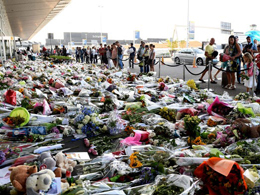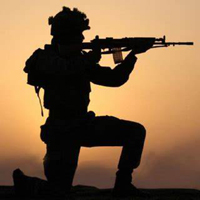Consciousness and health
The Physician and the Soldier
Both the physician and the soldier have certain things in common. Both have to face life and death in complex playing fields, both have to be spectators of gruesome tragedies and finally, both have to learn to be detached. But there are important differences.
The soldier does not know the person being killed by him. The soldier has no ethical concerns in killing.
The soldier is not going to face lawsuits for killing. The physician on the other hand knows the suffering patient and is liable to face legal action for therapeutic lapses.
The predicament of the soldier
It would be interesting to observe the ramifications of the physician’s and soldier’s actions.
The soldier today is a product of a long historical struggle which saw the institutionalisation of warfare. This necessitated the logical tradition of warrior classes in different denouements in different cultures.This age-old tradition was completely overturned during the two world wars when large masses of commoners were inducted into the army. If there had been no such world wars, the majority of these commoners would never have opted for being participants in the killing fields. The unfortunate result was that the phenomenon of reversal of ethical codes became the norm. What was unethical in civilian life became the standard in mass warfare. When the saga of the world wars ended, the ethical reversal extended as a norm in public space. Arnold Toynbee stated:
“One cause of the recent outbreak of lawless-ness in a number of different fields of life is the turning of millions of men into soldiers in the two world wars and in the many local wars that have also been waged since 1914. War is a deliberate reversal of the normal inhibition against taking human life. For a soldier, killing his fellow human beings is a duty instead of being the crime that it is if he commits murder as a civilian. This arbitrary and immoral reversal of a major ethical rule is bewildering and demoralising in itself. Moreover, a soldier on active service is torn out of his customary social setting and is therefore released from all his customary social restraints. When he is being commanded to kill, it is no wonder that he also ceases to be governed by other normal inhibitions against raping, looting and drug-taking. The demoralisation of the American troops in Vietnam was an extreme case of what always happens to soldiers on campaign (1).”
The physician’s predicament
The physician also learns to be detached when faced with terminal states of patients. But detachment per se has multiple connotations. A superficial detachment fosters a mechanical attitude where life and death have no value after a certain point. That is why a severely demented or terminally ill subject is spontaneously classified as being in a vegetative state which has no survival value. It is this mechanical attitude that has made the healthcare delivery system a commodity in the hands of corporate consumerism. And though the physician can be legally challenged for therapeutic lapses, there is a plethora of insurance companies to safeguard his interests. Moreover, understanding death, its metaphysical aspects, and its psychological and occult implications, have never been pursued by contemporary medical disciplines. As a result, our management of both passive and active euthanasia is riddled with dilemmas, while organ transplantation has many grey areas.
One intriguing dilemma rises when we have to reconcile an incisive cool-headed scientific approach of the medical technocrat with the compassion and love expected from the physician by society at large. A second dilemma arises in the physician’s psyche when one has to balance an evidence-based approach with an intuitive approach. Both these dilemmas have no rational solution. Yet we forcibly eulogise the rather exclusive mindset of rationality with the result that the therapeutic space becomes empty of spiritual values. Daisuku Ikeda commented:
“The more deeply imbued in the scientific way of thinking the doctor becomes, the more his mind is exposed to the danger of regarding humans as mere physical entities.The inescapable dilemma of modern medical science is this: science itself alters the personalities of the doctors who must employ its knowledge and skills and, at the same time, robs those doctors of respect for life (2).”
Yet in ancient India the science of healing was revealed to the rRssis while in Europe, medieval hospitals were consecrated to Christian saints. Toynbee points out the fact that the modern addressing of the nurse as sister and her secular uniform have their roots in history since the time Roman Catholic nuns began to serve God by nursing the sick. (3)
The synthetic approach
The predicament of the soldier, as well as that of the therapist, need to be approached from a synthetic perspective.The soldier’s dilemma can only be solved by a programme of global unity that would result in a sort of World State that would not be bereft of power but would have enough power-safeguards to deal with centrifugal disruptions. As Sri Aurobindo quipped:
“Diffused, force fulfils the free workings of Nature and is the servant of life but also of discord and struggle; concentrated, it becomes the guarantee of organisation and the bond of order (4).”
The therapist needs a more individualistic approach where therapy needs to be elevated to a healing art. The therapist needs to learn detachment while not ceasing to be loving and compassionate. This detachment does not mean a casual attitude where one is oblivious of the patient’s suffering. Rather, it is a detachment carried out at the level of the inner being where one can be free from the conflicts of the surface personality and yet carry the patient’s suffering in his or her consciousness to be dealt in a novel and innovative way. Ultimately it is at a yet deeper soul-level that the detachment becomes forceful and constructive.
The therapist also has to accommodate intuitive healing insights without disregarding an evidence-based rationalistic approach. This needs a growth of the therapist’s con-sciousness along an evolutionary trajectory, where one traverses supra-cognitive planes to reach the intuitive plane at higher echelons of Reality. One needs to surpass but not abandon rationality to access supra-rational realms. In this integralise paradigm, therapy per se becomes a veritable yoga.
References
1. Toynbee A, Ikeda D, (ed. Gage RL). Choose Life. A Dialogue. Indian ed. Delhi: Oxford University Press; 1987, p. 19.
2. Ibid., p. 89
3. Ibid.
4. Sri Aurobindo. The Complete Works of Sri Aurobindo, Volume 25. Pondicherry: Sri Aurobindo Ashram Trust; 1997, p..484.
Share with us (Comments, contributions, opinions)
When reproducing this feature, please credit NAMAH, and give the byline. Please send us cuttings.



